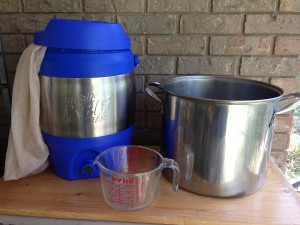
A 3-gallon (11-L) brewery set up capable of brewing all-grain beer up to an OG of 1.048 or partial mash beer at any OG.
Bigger is better, right? As I pointed out in a previous article about scaling your batch size up or down to fit your needs, smaller is sometimes the way to go. (And if it isn’t, see my article on scaling up.) For apartment dwellers, scaling down from 5.0 gallon (19 L) batches might be beneficial due to space limitations. Brewing smaller batches can also be a good idea when brewing an experimental beer, or a beer style you’re not sure if you’re going to like. For example, if you’ve never tried a smoked beer before, but are curious, it may be better to generate a couple gallons of the beer rather than the usual 5.0 gallons (19L). Beer with expensive ingredients or very large grain bills are also good candidates for a smaller-sized batches. And of course, if you like to brew more than you like to drink, and the beer is piling up, scaling down may yield a more manageable beer inventory.
How Much Beer Are We Talking About?
In this article, I’ll discuss the ins and outs of making batches of homebrew in the 2.0-gallon (7.6-L) to 3.0-gallon (11-L) range. Three gallons (11 L) of beer will yield thirty-two 12-oz. (355 mL) bottles of beer. That’s a case, a six pack, and two more bottles. Compare that to the fifty-three bottles — just over two cases — that a 5.0-gallon (19-L) batch generates. For 2.5 gallons (9.5 L), the yield is 26 bottles, two bottles more than a case. Two gallons (7.6-L) yields twenty-one bottles,three bottles short of a case. Brewing this volume will take roughly the same amount of time as brewing 5 gallons (19 L), although your heating and cooling times may be shorter.


Recent Comments